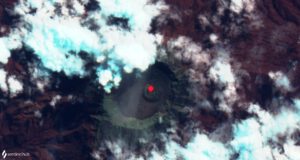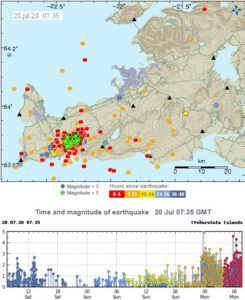 The volcano Raung is located in the east of the Indonesian island of Java and has been under special observation by local volcanologists for several days. Seismic signals signalled the awakening of the volcano. Small ash clouds were also sighted rising above the crater rim. Now there is a further indication of the increasing activity of the volcano: the sentinel satellites detected a heat source. It emits radiation with a power of 33 MW and is located at the northern rim of the small crater that had formed in the caldera in 2015. The crater is part of an intra-caldera cinder cone. The evidence suggests strombolian activity. Visual observations of the crater rim have not been reported to me. Raung is part of the Ijen volcanic massif, which also includes the better known sulfur-producing Kawah Ijen.
The volcano Raung is located in the east of the Indonesian island of Java and has been under special observation by local volcanologists for several days. Seismic signals signalled the awakening of the volcano. Small ash clouds were also sighted rising above the crater rim. Now there is a further indication of the increasing activity of the volcano: the sentinel satellites detected a heat source. It emits radiation with a power of 33 MW and is located at the northern rim of the small crater that had formed in the caldera in 2015. The crater is part of an intra-caldera cinder cone. The evidence suggests strombolian activity. Visual observations of the crater rim have not been reported to me. Raung is part of the Ijen volcanic massif, which also includes the better known sulfur-producing Kawah Ijen.
Day: July 21, 2020
Iceland: Strong earthquake swarm on Reykjanes
 The Icelandic peninsula of Reykjanes is again hit by a strong Earthquake swarm. The strongest single quake had a magnitude of 5.0 and manifested itself 1.6 km northwest of Fagradalsfjall, with a hypocentre at 10 km depth. Fagradalsfjall is the highest elevation on Reykjanes with a height of 385 m and lies east of Grindavik. In the end, the epicentre of seismic activity shifted a little to the east, starting from the quake spot north of Grindavik where most of the previous earthquakes occurred.
The Icelandic peninsula of Reykjanes is again hit by a strong Earthquake swarm. The strongest single quake had a magnitude of 5.0 and manifested itself 1.6 km northwest of Fagradalsfjall, with a hypocentre at 10 km depth. Fagradalsfjall is the highest elevation on Reykjanes with a height of 385 m and lies east of Grindavik. In the end, the epicentre of seismic activity shifted a little to the east, starting from the quake spot north of Grindavik where most of the previous earthquakes occurred.
IMO recorded a total of 936 earth tremors in the Reykjanes area in the last 48 hours. 16 quakes had magnitudes greater than 3, some of them even stronger than M 4.0. I assume that the quakes are related to further magma intrusion. However, an IMO report on this is still pending. However, the Icelandic Meteorological Authority reports that the stronger earth quakes were felt in the southwest of Iceland.